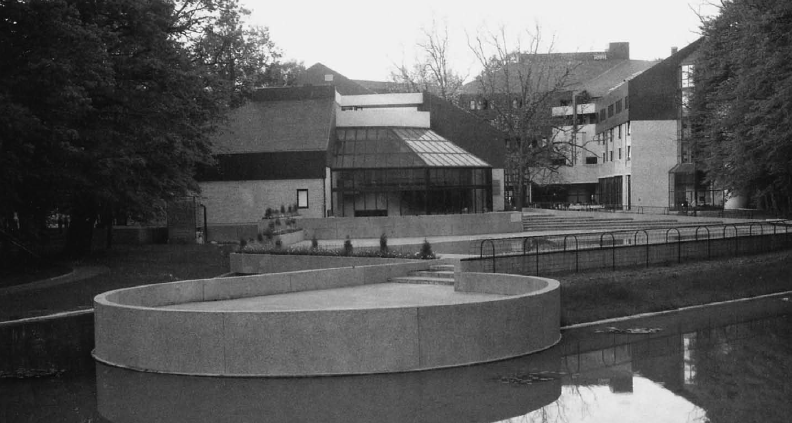Slavonia Hotel System
Planning and Programme Starting Points, Architectural Concept and Realization (1974-1982)
DOI:
https://doi.org/10.31522/p.33.1(69).5Keywords:
construction of tourist facilities, Croatian tourism, hotel architecture, Salaj, Matija, Slavonia Hotel System (SHS)Abstract
A project that stands out among Croatian hotel architecture of the second half of the 20th century is the unique Slavonia Hotel System (SHS), designed in the mid-1970s by a team of experts from the Urban Institute of Croatia and headed by architect Matija Salaj. The SHS project was based on the principle of standardization in terms of spatial-functional organization, architectural design, interior design, furnishing and visual communication elements as well as operation and market penetration, and was envisaged as the driving force behind continental tourism development in Slavonia and Baranja. This paper examines the planning framework, program specifications, and urban-architectural design of the hospitality and tourist facilities of the SHS (including a city hotel model in two variations, a spa hotel, and a motel) by utilizing sources from Salaj’s estate and archival documentation from the Urban Institute. Notably, it includes Salaj’s explanations of the SHS project and his perspectives on the features of hospitality and tourist facility architecture, as presented in professional journals and conference publications. These aspects are complemented by a review of tourism development trends in the 1970s and the characteristics of hotel architecture in market economy.
References
Andrić, N. (ed.) (1977) Turizam, značajan faktor društveno ekonomskog razvoja Jugoslavije. Savjetovanje održano u Splitu 21-23. siječnja 1976. Zagreb: Ekonomski pregled, pp. 11-28.
Anonim [Čovjek i prostor] and Salaj, M. (after 2000) Arhitekt Matija Salaj (unpublished).
Antešević, N. (2022) Arhitektura modernih turističkih objekata u Jugoslaviji (1930-1985). Ph.D. in Art History. Filozofski fakultet Univerziteta u Beogradu. https://nardus.mpn.gov.rs/handle/123456789/20641
Antešević, N. (2023) ‘Nasleđe turističke arhitekture 20. veka - izazovi u obnovi i održivom korišćenju’. In: Pavlović, M. and Mrlješ, R. (eds.) Zaštita graditeljskog nasleđa u 21. veku: izazovi i mogućnosti. XII međunarodna naučno-stručna konferencija. Beograd: Zavod za zaštitu spomenika kulture grada Beograda, pp. 132-145.
Bachvarov, M. (1999) ‘Troubled sustainability: Bulgarian seaside resorts’, Tourism Geographies, 1, pp. 192-203. https://doi.org/10.1080/14616689908721309
Balcerzak, A. (2021) ‘The Charm of the PRL. Memory Culture, (Post)Socialist Nostalgia and Historical Tourism in Poland’, Slovenský národopis / Slovak Ethnology, 69, pp. 255-273. https://doi.org/10.2478/se-2021-0014
Butler, R.W. (1980) ‘The concept of a tourist area cycle of evolution: implications for management of resources’, Canadian Geographer, 1, pp. 5-12. https://doi.org/10.1111/j.1541-0064.1980.tb00970.x
Carević, A. and Šimičić, V. (1988) ‘Turistički objekt od ideje do ostvarenja’, Turizam, 36 (11-12), pp. 287-291.
Čaldarović, O. (1980) ‘Neki elementi sociološke valorizacije tendencija postmoderne arhitekture’, Arhitektura, 172+3, pp. 57-58.
Čomić, Đ. (1983) ‘Uticaj prostorne strukture receptivne regije na razmeštaj turističkih objekata’, Turizmologija, 14, pp. 55-65.
Delalle, R. (1980) ‘Uvod u postmodernu arhitekturu’, Arhitektura, 172+3, pp. 45-48.
Dženks, Č. (2016) Šta je postmodernizam? Loznica: Karpos.
Haberle, M. (1976) ‘Spomen-dom „Đuro Salaj” u Slavonskom Brodu’, Arhitektura, 158+9, pp. 78-82.
Kiš, D. (1977) ‘Ovisnost turizma o potencijalima pejzaža’, Turizmologija, 2, pp. 43-50.
Kranjčević, J. (2021) ‘Turističko i prostorno planiranje u Hrvatskoj i Jugoslaviji 1960-ih’, Časopis za suvremenu povijest, 53(3), pp. 1183-1207. https://doi.org/10.22586/csp.v53i3.18737
Kranjčević, J. and Stober, D. (2023) ‘Prostorno planiranje i turizam Slavonije - povijesna iskustva za planiranje budućnosti’. In: Bratulić, J. and Dabo, K. (eds.) Zbornik radova: Kontinentalna Hrvatska: povijesni kontekst, aktualnosti i perspektive u budućnosti (1). Zagreb: Zavod za znanstveni i umjetnički rad Hrvatske akademije znanosti i umjetnosti u Đakovu; Institut za istraživanje migracija, pp. 647-664.
Kritovac, F. (1971) ‘Kako da vidimo ono što ne gledamo. Neki projektni kriteriji turizma’, Čovjek i prostor, 28(224), p. 18.
Kulić, V.; Mrduljaš, M. and Thaler, W. (2012) Modernism in-between: The mediatora architecture of socialist Yugoslavia. Berlin: Jovis.
Light, D.; Creţan, R.; Voiculescu, S. and Jucu, I.S. (2020) ‘Introduction: Changing Tourism in the Cities of Post-communist Central and Eastern Europe’, Journal of Balkan and Near Eastern Studies, 22, pp. 465-477. https://doi.org/10.1080/19448953.2020.1775405
Magaš, B. (1997) ‘Zgrade, hotelske’. In: Štefanović, D. (ur.) Tehnička enciklopedija, Tom 13 [Ter-Ž]. Zagreb: Leksikografski zavod Miroslav Krleža, pp. 603-613.
Mandarić, A. (1965) ‘Turizam i privredna reforma’, Turizam, 8(8-9), pp. 2-3.
Milas, M.D. (ed.) (1997) Hrvatski prostor - temeljno nacionalno dobro. Okrugli stol UIH 1947-1997. Zagreb: Urbanistički institut Hrvatske.
Mitrović, M. (1970) ‘Izbor lokacije za izgradnju turističkih objekata u Jugoslaviji’. In: Izgradnja i opremanje turističkih objekata. Prateće manifestacije na jubilarnom V Međunarodnom sajmu građevinarstva Zagreb. Beograd: Organizacioni odbor V sajma građevinarstva, Jugoslavenski građevinski centar, pp. 1-16.
Mrduljaš, M. (2011) ‘Razvoj turizma na hrvatskoj Jadranskoj obali u socijalizmu: izgradnja dostupne arkadije’, Čovjek i prostor, 57(684-685), pp. 33-45.
Mrduljaš, M. (2013) ‘Building the Afforadable Arcadia. Tourism development on the Croatian Adriatic coast under state socialism’. In: Beyer, E., Hagemann, A. & Zinganel, M. (eds.) Seaside Architecture and Urbanism in Bulgaria and Croatia. Holidays after the Fall. Berlin: Jovis, pp. 171-207.
Mrduljaš, M. (2018a) ‘Arhitektura: tabula rasa, konteksti, kritika’. In: Author’s group. Šezdesete u Hrvatskoj - Mit i stvarnost. Zagreb: Školska knjiga, pp. 164-189.
Mrduljaš, M. (2018b) ‘Toward an affordable Arcadia: The evolution of hotel typologies in Yugoslavia, 1960-1974’. In: Stierli, M. and Kulić, V. (eds.) Toward a Concrete Utopia: Architecture in Yugoslavia, 1948-1980. New York: The Museum of Modern Art, pp. 78-83.
Mrduljaš, M. and Kulić, V. (2012) Nedovršene modernizacije: izmedju utopije i pragmatizma / Unfinished modernisations: between utopia and pragmatism. Zagreb: Croatian Architect’s Association.
Mrinjek Kliska, N.; Bojanić Obad Šćitaroci, B. and Mrđa, A. (2019) ‘Utjecaj ubrzanog zastarijevanja u turizmu na hotelske zgrade’, Prostor, 2(58), pp. 310-321. https://doi.org/10.31522/p.27.2(58).10
Nešić, M. (1972) ‘O nekim problemima finansiranja turističke izgradnje u sadašnjim uslovima’, Turizmologija, 1(1), pp. 111-114.
Puhmajer, P. (2010) ‘Istraživanje Kursalona u Lipiku’, Portal: godišnjak Hrvatskoga restauratorskog zavoda, 1, pp. 45-61.
Rakić, D. (1965) ‘Natječaj za hotel u Virovitici’, Arhitektura, 90, pp. 61-62.
Rosenbaum, A.T. (2015) ‘Leisure travel and real existing socialism: new research on tourism in the Soviet Union and communist Eastern Europe’, Journal of Tourism History, 7, pp. 157-176. https://doi.org/10.1080/1755182X.2015.1062055
Rošin, J. (1977) ‘Arhitektura i turizam’. In: Antunac, I. and Jadrešić, V. (eds.) Humanističke vrijednosti turizma. Zadar: Pedagoška akademija Sveučilišta u Zadru, pp. 371-376.
Rošin, J. (2023) ‘Matija Salaj’. In: The Architects Unplugged. Zagreb: Alfa, pp. 308-314.
Salaj, M. (1982a) ‘Funkcija arhitekta u planiranju i projektovanju turističke izgradnje’. In: Jagodić, D. (ed.) Šesti simpozijum „Hotelska kuća 82”, Opatija, 25-27. X 1982. Opatija: Centar za ekonomske i organizacijske znanosti Sveučilišta u Rijeci; OOUR Hotelijerski fakultet Opatija; Opšte udruženje turističke privrede Jugoslavije Beograd, pp. 85-94.
Salaj, M. (1982b) ‘Oblici izgradnje i psihofunkcija turističkog objekta i lokaliteta’, Čovjek i prostor, 29(7-8), pp. 10-11.
Salaj, M. (1982c) ‘Hotelski sistem Slavonija’, Čovjek i prostor, 29(7-8), pp. 21-24.
Salaj, M. (1989) ‘Arhitektura u službi turističkog razvoja’, Acta turistica, 1(1), pp. 61-71.
Salaj, M. (ed.) (1987) Urbanistički institut Hrvatske 1947-1987. Zagreb: Urbanistički institut Hrvatske.
Salaj, M.; Krznarić, Z.; Stipančić, A. and Vukonić, B. (1974) Hotelski sistem Slavonija: programski pokazatelji i osnovne studije smeštajnih kapaciteta (1) [study]. Urbanistički institut SR Hrvatske, Interesna zajednica za razvoj ugostiteljstva i turizma Slavonije, Zagreb.
Salaj, M.; Stipančić, A. and Krznarić, Z. (1975) ‘Hotelski sistem (lanac) Slavonija - rad u radnoj grupi R-3 i R-5’, Bilten - Urbanistički institut SR Hrvatske, 5, pp. 15-24.
Stefan, A. (2023) ‘Unpacking Tourism in the Cold War: International Tourism and Commercialism in Socialist Romania, 1960s-1980s’, Contemporary European History, 32, pp. 365-384. https://doi.org/10.1017/S0960777321000540
Stipančić, A.; Salaj, M. and Krznarić, Z. (1975) Hotelski sistem Slavonija: programski pokazatelji i elementi osnovnih modela sistema (2) [study]. Urbanistički institut SR Hrvatske, Interesna zajednica za razvoj ugostiteljstva i turizma Slavonije. Zagreb.
Svorcan, N. (2009) Međunarodni hotelski lanci. Beograd: Visoka hotelijerska škola.
Šerman, K. and Mrduljaš, M. (2016) ‘Moderna tradicija hrvatske turističke arhitekture’. In: Radić, Z. (ed.) More - hrvatsko blago. Zagreb: Vlastita naklada Z.R., pp. 1056-1062.
Vukonić, B. (2005) Povijest hrvatskog turizma. Zagreb: HAZU; Prometej.
*** (1976a) 11. Zagrebački salon: arhitektura i urbanizam. Zagreb: Društvo arhitekata Zagreba.
*** (1976b) Izložba projektne dokumentacije za robnu kuću, hotel, podvožnjak. Galerija umjetnosti Vinkovci - Likovni salon JNA, Vinkovci.
*** (1982) 17. Zagrebački salon: arhitektura i urbanizam. Zagreb: Društvo arhitekata Zagreba.
*** (1987) Hotel ‘Beli Manastir’ [study] Urbanistički institut Hrvatske, Zagreb.

Downloads
Published
Issue
Section
License
Copyright (c) 2025 Nebojša Antešević, Jasenka Kranjčević

This work is licensed under a Creative Commons Attribution 4.0 International License.
Copyright (c) 2021 authors and journal.
This work is licensed under a Creative Commons Attribution 4.0 International License.
Authors who publish with this journal agree to the following terms:
In agreeing this form, you certify that:
- You read the ethical codex of the PROSTOR available at journal web.
- You submitted work is your original work, and has not previously been published and does not include any form of plagiarism.
- You own copyright in the submitted work, and are therefore permitted to assign the licence to publish to PROSTOR.
- Your submitted work contains no violation of any existing copyright or other third party right or any material of an obscene, libellous or otherwise unlawful nature.
- You have obtained permission for and acknowledged the source of any illustrations, diagrams or other material included in the work of which you are not the copyright owner.
- You have taken due care to ensure the accuracy of the work, and that, to the best of your knowledge, there are no false statements made within it.
- All co-authors of this submitted work are aware of, and in agreement with, the terms of this licence and that the submitted manuscript has been approved by these authors.






